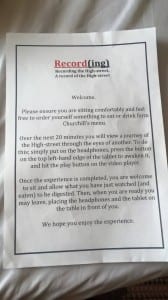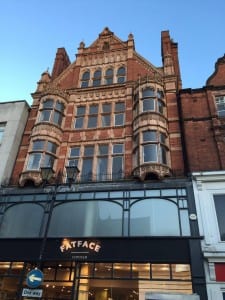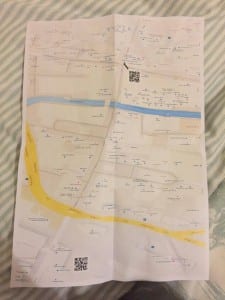THESE BLOODY TRAIN LINES: KAI VALENTINE – FINAL BLOG SUBMISSION

FRAMING STATEMENT
Site Specific Performance
Site specific performance is defined by Pearson as ‘staging and performance conceived on the basis of a place in the real world.’ (Pearson, 2010, 7). The performance should link to the site in which you are performing in, and make a connection or create a response that may not be possible if the same piece was performed at another site. The high street was our given site. Even though it was an environment that I visit on a regular basis, I had not taken the time to stop, look around and indulge in my surroundings. On doing so we discovered the site that we wished to base our piece from. The train lines.
‘These Bloody Train Lines’ was a site specific performance, on the 6th May 2016. The tour took place three times at 11am, 11:30am and 2:30pm, lasting approximately 20 minutes in length. The performance involved two actors giving an informal and uninformed guided tour. The tour begins at St Mark’s Square, the site of a former train station, and concludes at the train crossing on the high street. Both sites have a rich history and link between each other, encouraging members of the tour to notice the history, then a comedic song is performed by myself with lyrics composed from a collection of responses of what would make people happy when waiting at the train line. The audience gathered at the crossing are given a lyrics sheet, encouraging engagement. The piece was performed by Francesca Bolingbroke, Christopher Clarkson and I, with accompaniment from guitarist Jordan Makin.
The train line that runs through the centre of Lincoln is a major geographic interest for many visitors. People aren’t exactly queuing up to go visit it, that honour is bestowed to the Cathedral and the Castle up the hill. Yet, the fact it not only through the centre of the high street, but also the University campus, is something that visitors often comment on and are baffled by. What drew me to this particular site was the anthropology behind it. People really don’t enjoy having their day interrupted by the loud signals, flashing lights and agonising waits as 26 carriages (yes I counted) of a freight train crawl past.
The high street is generally a happy place, conversely the misery that surrounds the train line is insurmountable. ‘It causes severe disruption and endless anger amongst residents of the city.’ (Santos, 2013) If you get stuck there, expect an infuriating wait surrounded by road works, an overdue work-in-progress bridge and other irritated members of the public who have, like you, had their day forced to a halt.

Our aim was to make the wait at the train line not the melancholy situation it is at present, but instead a vibrant, happy, and dare I say, fun experience. The audience are an interesting part of our piece. The tour will be intimate, however the audience when at the crossing is unpredictable. Whoever is at the train line have no choice but to be there, if they want to travel to the other side. This creates an interesting dynamic as they could be either entertained and interested, our aim, or they could be irritated and actually more annoyed that we are there. Watching the different ways that people respond is one of the most fascinating parts of the piece.
PROCESS
History
The process towards our piece began with a simple walk up and down the high street. On this walk I took in information on the buildings, the architecture and things that I had never taken the time to notice before, all because I’d usually been pre-occupied or my mind elsewhere. It was on this walk I noticed the ‘British Railways, Lincoln, St Marks’ sign. This inspired the history tour side of our piece.

To develop the idea I spent three days scouring the archives of the Lincolnshire Echo. I discovered articles from when the station closed in 1985, due to the trains being diverted towards Lincoln Central Station, to ease issues with having two rail crossings and a change in how rail tracks could be formatted rendering St Marks Station useless. It would later reopen in 1996 as the shopping centre we see today after Debenhams announced they wanted to open a large store in the centre of Lincoln. This research was the historical stimuli for our piece.
Wrights and Sites influenced the tour aspect of our piece. We aren’t quite doing a ‘misguide’ tour like they do where they let the audience explore the site the entire time on their own, however we are allowing the audience to consider their own relationship with the site, the journey and time they are taking, something which will hopefully stick with them next time they return to the site.
Anthropology
In the second week, we watched John Smith’s ‘Girl Chewing Gum’. This piece inspired us to go out onto the high street and take the same journey that we did the previous week, however instead of concentrating on the architecture, and the history, concentrate on the people.
We embarked to the high street, stopping at different places, watching people, commenting on what they are doing, and describing their actions as if directing them, like Smith. Inspired by ‘Girl Chewing Gum’ when Smith makes the comment ‘Steele’s is situated in an area with a high immigrant population’ (ewwtubes, 2011), at moments in the activity I’d give random facts about the site and our surroundings that had no link to what the people around me were doing.
Smith’s interruptions and mentions of not only facts, but also personal comments like ‘Until recently I thought the jobs on the board were advertised in two languages’ (ewwtubes, 2011), was a groundwork inspiration for the role that Chris would play in the piece. Interrupting Fran’s historical information with quips of own experiences, asking questions and breaking away from the tour to buy chips.
In the early stages we discussed tacit agreements. ‘Tacit refers to something done or made in silence.’ (The Legal Dictionary, 2006). Tacit agreements are the decisions and rules that are made by ourselves, unwritten rules that are understood and not discussed. I’m interested in how these tacit agreements would link to the train lines, and most importantly, how we could break them. Sitting down, watching people, I realized quickly I’d broken my first tacit agreement. People don’t enjoy being watched and were quite wary of any interaction. Some also found it strange that I was sat down, in an area that people normally wanted to leave.
The train line crossing is a non-place. ‘A place that cannot be defined as relational, or historical, or concerned with identity will be a non-place’ (Auge, 1995, 77). The crossing isn’t somewhere people go to visit, they may pass through, or even get stuck there, but not on purpose. We aimed to change that by breaking the tacit agreements and understandings of waiting at the barriers. It has become understood that you don’t generally interact with people, as they’ve had their day interrupted and are usually irritated, but what if everybody was feeling the same? What if everybody is just too scared to interact and break these agreements?
By performing there, we’re breaking these tensions, people are encouraged to interact and take this action next time they are here once the performance is over. ‘After the ‘substantive’ notion of site, such site-specific work might even assert a ‘proper’ relationship with its location, claiming an ‘original and fixed position’ with what it is.’ (Kaye, 2000, 1). Once our piece is over, people will remember what they witnessed next time they are stuck at the train lines, and remember how we made them smile.
Misery into Happiness
We wanted to find a way to turn the misery into happiness. To do this this we gathered information by approaching the public with a simple question: ‘What would make you happy?’, only doing so when the barriers were down, at their most irritated. Responses ranged from ‘not to get a warning for being late to work’ to a young gentleman with his girlfriend, who proclaimed ‘her Dad to stop being a prick’.
Adrien Howells’ discusses in Salon Adrienne (2006) that he is ‘bonding with people and having a confessional exchange with them’. I kept this in mind when carrying out this task. For some people, answering this question was all they wanted to do, which we respected. Some people took this opening question and opened up a conversation that let us delve into their personal life and gather more information that gave us a well-rounded view on not only what made them happy, but why it made them happy.
We approached one lady, who struggled to understand English, however when she understood what we were asking her she replied that seeing her family and friends would make her happy. I asked her where they are and she explained that they were in Spain, she had recently moved to the UK and was still settling in. She told us about her children, and how they have felt since the move. In this moment, a simple confessional conversation about how miserable the train lines were had brought back memories of happiness for her, making her smile, whilst standing in a place of misery.
Having the audience co-author our piece was inspired by Howells and Farquhar. Farquhar’s ‘Onwards Tour’ depended on how the audience reacted live during the tour, and any questions that members of the audience ask in the present that cannot be predicted. Farquhar refers to this as ‘edited in the moment’ (2011). We had to prepare for this as due to the informality and intimate nature of the tour, like Onwards Tour, it was likely people would ask further questions about the history you are explaining or question the validity of your facts. Walking some volunteers through an early draft of the tour, whilst stood next to the tribute to the station inside the old entrance, one tour member asked whether where we were standing would have been the old platform, at the time Fran did not know the answer to this, she responded with an educated guess and asked the volunteer their opinion. The audience involvement makes the piece a ‘one occasion, and it is what it is.’ (ReCreative, 2011), with no two tours exactly the same.

I believe that comedy is not only the best way to make someone happy, but the best way to keep attention. I was inspired to use comedy in our piece after watching Joshua Sofaer’s ‘What is Live Art?’. Sofaer breaks the social boundaries of a public performance, people aren’t really interested in what he is saying, but due to the comedy, attention is grasped and they may learn something. Humour is a vital part of performance, it draws in attention and makes people interested in engaging with you.
Early Forms to the Final Product
We had the information gathered, we knew that we wanted to give a historical tour and attempt to make the people waiting by the train line happy. Now we just needed to work out how we were going to achieve this.
Forced Entertainment’s Speak Bitterness inspired our initial idea to sit by the train crossing and every time the barriers came down we’d stand up and read out the verbatim responses we had gathered, creating amusement in an awkward, confusing, but entertaining moment. However we felt more audience engagement would be effective.
Care was a massive stimuli for the early planning of our piece. Howells discusses in Salon Adrienne (2006) how he wants to care for people. Our next idea was to have a gift stall by the train line where people would receive gifts at the end of the tour. These included a penny to represent money, cakes, McDonalds, all things people said would make them happy.
Our final idea was putting the responses we had gathered into a song. Taking the list I put them to the tune of Don’t Look Back in Anger by Oasis, this being a well-known tune that people would recognise and be able to sing along to. However we found that this lead people to think of pre-existing memories they had of Oasis, we didn’t want this, we wanted to concentrate on the site. I worked alongside Jordan Makin in re-writing the lyrics to an original tune. We decided the gift stall was not necessary to the final piece, as the song was a gift.

(Bolingbroke, 2016)
The original plan was that Jordan and I would be at the end of the tour as buskers. Farquhar discusses ‘the idea of things not being known whether they are intentional, whether they were put there by me or not.’ (Re-Creative, 2011). We kept this in mind as the tour members wouldn’t know whether I was part of the tour or there by happy accident. In the final rehearsals we decided it’d be more effective if we joined the tour midway through, after becoming interested.
For the final rehearsal, Fran and Chris presented the tour to Jordan and me. We then performed the song when the barriers lowered. We didn’t envisage the barriers would lower for 20 minutes. Due to the long wait, it became our largest crowd to date. We took into account that if this happened the next day we’d need to keep performing in order to keep them entertained and create our aim of happiness.
PERFORMANCE EVALUATION

The way in which to measure this performance’s success is through audience reaction. We were working to two audiences, the small group of tour members, alongside the open audience stuck at the train crossing. Overall both showed signs of enjoyment. I would say the piece was successful.

Tour members recalled that they found the historical nature interesting, they asked questions and informed us they hadn’t noticed the things they’d pointed out before. The audience at the crossing had a range of reactions. Some were enthusiastic to get involved, nodding along to the music, and afterwards threw money, gave a thumbs up and smile, and an old lady gave me a sweet and told me to keep spreading the happiness. Some people however did not enjoy our breaking of tacit agreements and became irritated by our presence, this interested me though as one person on the tour proclaimed that you can’t make everybody happy, which is very true. You can see in the video below that during this particular performance some people are actively trying to avoid engaging with us.
Figure 8: Performance of ‘These Bloody Train Lines’ by Kai Valentine and Jordan Makin. The 8th Performance of the day. (ChezzaXD, 2016)
In trying to keep the tour intimate we only invited a select amount of people, however as some people did not show, we had a maximum of three people on each tour. Next time we would take this into account. At the crossing, throughout performing the song 9 times, we performed to around 200 people. Alongside gathering the responses to the questions and rehearsing before-hand, hundreds of people were involved in the process.
The performance was still constantly changing. With small numbers, and generally the audience knowing I was a part of it, joining the tour mid-way felt acted and fake. In the later performances, Jordan and I sat by the chip shop when the tour came by, we didn’t acknowledge them. The tour would then move on without us, and we would follow on shortly. An interesting dynamic was created, the people who didn’t know previously I was part of the tour remembered spotting us at the chip shop earlier, and it was also a surprise for the people who knew I was part of the cast, as they were expecting me to become involved when they first came across us.
I’d be interested in seeing how the tour dynamic worked with a larger audience. I’d also like to have the performance at the crossing become a durational aspect, staying by the train lines and performing each time they lowered as it was fascinating that each audience responded differently.


Working on site specific work has broadened my horizons to what theatre and performance can be and that there are so many different ways in which you can engage with audiences and create reactions that you cannot simulate in a traditional theatre venue. ‘‘Theatre in the mind’ may be made up of a physical memory of all of an individual’s previous performances’ (McLucas, 1993, 3). I have dropped the notions of what I once considered to be the boundaries of theatre. Performance has no limits.
Word Count: 2750
Citations and References:
Auge, M. (1995) Non-places: introduction to an anthropology of super modernity. London: Verso.
ChezzaXD (2016) These Bloody Train Lines. [online video] available from https://www.youtube.com/watch?v=iwP0SJsTfeg [accessed 12 May 2016].
Ewwtubes (2011) John Smith: The Girl Chewing Gum 1976. [online video] Available from https://www.youtube.com/watch?v=57hJn-nkKSA [accessed 11 April 2016].
Homotopia Festival (2007) Salon Adrienne. [online video] Available from https://www.youtube.com/watch?v=mmUn2ZTzeY0 [accessed 10 April 2016].
Kaye, N. (2000) site-specific art performance, place and documentation. Oxon: Routledge.
Legal Dictionary. (2006) Collins Dictionary of Law: Tacit Agreement. [online] Chicago: The Legal Dictionary. Available from http://legal-dictionary.thefreedictionary.com/tacit [accessed 2 May 2016].
McLucas, C. (1993) The Host and the Ghost. NLW: Brith Gof Archive.
Pearson, M. (2010) Site Specific Performance. Hampshire: Palgrave Macmillan.
ReCreative (2011) Ideas Factory: Marcia Farquhar. [online video] Available from https://vimeo.com/28359607 [accessed 15 April 2016].
Santos, C. (2013) Lincoln’s past: A tale of two crossings. [online] Lincoln: The Lincolnite. Available from http://thelincolnite.co.uk/2013/02/lincolns-past-a-tale-of-two-crossings/ [accessed 20 April 2016].






















